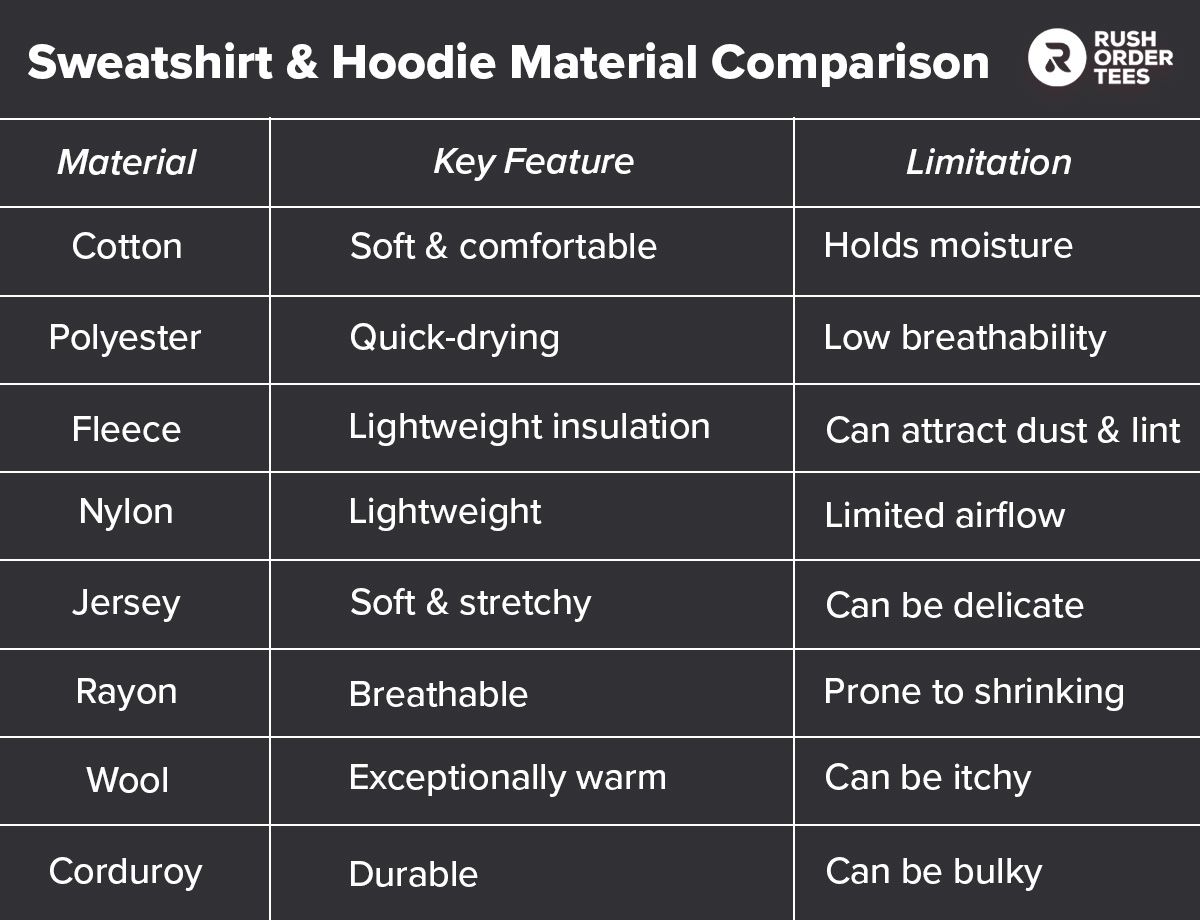
What’s the Best Sweatshirt & Hoodie Material?
It’s hard not to feel like Goldilocks when you’re trying to pick the right material for a custom sweatshirt — you likely want something warm but not too hot, soft but still durable, or flexible but resilient.
While you may not be able to settle on a material that has all the qualities you want with no compromise, there are enough options that you should be able to find one that has the characteristics you value most. Whether you’re looking for the softest, the most durable, or the most functional fabric, this guide to the best sweatshirt materials should help you pick the one that suits your tastes.
What Materials Are Sweatshirts and Hoodies Made From?

Custom hoodies and sweatshirts can be made from many different materials, most often cotton, polyester, or a blend of the two. However, there are plenty of other options for those with specific garment qualities in mind.
Cotton
Key feature: Soft and comfortable
Limitation: Holds moisture
If you’re looking for comfort, you’re looking for cotton. A classic choice for sweatshirts and hoodies, cotton is soft, comfortable, and breathable. This natural sweatshirt material is also very absorbent, which means it’s probably not going to be your top choice for performance wear, since it can tend to hold in sweat and odor. It can also be prone to wrinkles and may shrink if not cared for properly, but in terms of pure comfort, it’s hard to do better than 100% cotton products like the Comfort Colors Unisex Lightweight Cotton Hoodie.
Polyester
Key feature: Quick-drying
Limitation: Low breathability
Possibly the most popular synthetic material used for sweatshirts and hoodies, polyester is durable, wrinkle-resistant, and quick-drying. It's often used in blends with other materials (like the aforementioned cotton) to enhance performance — athletic brands like Under Armour and Nike use it for its moisture-wicking properties for garments like the Hustle Pullover Hoodie. However, polyester can be less breathable than natural fibers and may not be as soft.
Fleece
Key feature: Lightweight insulation
Limitation: Can attract dust and lint
Technically a form of polyester, fleece is a soft, warm synthetic fabric characterized by its fuzzy, textured surface, which creates tiny air pockets that trap heat, making it a great insulator. It’s also fairly wrinkle-resistant, durable, and is generally lighter than other insulating materials, so a fleece layer like the Nike Club Fleece Crew is an ideal option for wearing around the office or as a base layer. It’s also prone to generating static, which can attract dust and lint.
Nylon
Key feature: Lightweight
Limitation: Limited airflow
Nylon is another durable synthetic material you’ll find in sweatshirts and hoodies, particularly lightweight, water-resistant options. Nylon is quick-drying, wrinkle-resistant, and holds up well against wear and tear, but like polyester, it’s also tight-woven and can tend to feel a little stuffy when it’s only moderately cold.
Jersey
Key feature: Soft and stretchy
Limitation: Can be delicate
A knit fabric commonly found in casual sweatshirts and hoodies, jersey is most easily identified by its soft, stretchy texture. While it was originally made from wool, it's now typically made from cotton or a blend of cotton and other synthetic materials. Jersey is comfortable and breathable, but it can be prone to pilling and isn’t the most durable of sweatshirt and hoodie materials.
Rayon
Key feature: Breathable
Limitation: Prone to shrinking
A semi-synthetic option, rayon is often used for its silky feel and drape. Made from cellulose, a natural material found in plants, it undergoes chemical processing to create the final fabric so it sits somewhere between natural and human-made. As the District Perfect Tri Fleece Zip Up Hoodie demonstrates, it's breathable and comfortable, but it can be sensitive to heat and may shrink if not cared for properly.
Wool
Key feature: Exceptionally warm
Limitation: Can be itchy
As one of the oldest garment materials known to humankind, this natural fiber is still prized for its unparalleled warmth and insulation properties. As such, wool is often used in premium, functional sweatshirts and hoodies like the Brooks Brothers Merino Birdseye Quarter-Zip Sweater designed to help you withstand cold weather. Wool can be itchy for some people, but it's durable and naturally moisture-wicking.
Corduroy
Key feature: Durable
Limitation: Can be bulky
Corduroy is a less commonly used option characterized by its raised, parallel ridges, often referred to as "wales," which give it a distinctive texture and appearance. Corduroy is typically made from cotton, but it can also be made from other natural fibers like wool or synthetic ones like polyester. It’s often used for heavier-weight sweatshirts and hoodies and is known for being particularly durable and warm, but it can also be less breathable than other sweatshirt materials.
Material Blends
Sweatshirt and hoodie materials aren’t set in stone (literally or figuratively) — many of the garments produced today actually contain more than one of the above. Blends help leverage unique benefits from one material to supplement the limitations of another, making garments lighter, capable of moisture-wicking, more cost efficient, etc.
Cotton and polyester are the most popular materials to blend for sweatshirts and hoodies and typically get divided into either 50/50—like the Gildan Heavy Blend Fleece Sweatshirt —or 85/15 in favor of cotton—like the Hanes Ultimate Cotton Fleece Sweatshirt in “Light Steel” (though even finer breakdowns are also possible).
There are also tri-blends like the Alternative Champ Eco-Fleece Solid Sweatshirt,that incorporate a third material into the mix — for example, a cotton/polyester/rayon blend is a popular melding of cotton’s softness, polyester’s moisture resistance, and rayon’s lightweight flexibility.
Natural vs. Synthetic Materials
Each of these materials falls into one of two camps — natural or synthetic (or in some cases, both). Natural materials can be harvested and processed to use for making garments, while synthetic materials are developed to offer specific qualities that can be harder or more expensive to come by in nature. Each has its own advantages and drawbacks.

Generally speaking, natural materials tend to offer better durability, comfort, breathability, and sustainability. On the flip side, synthetic materials are usually more moisture-wicking, lighter, more wrinkle-resistant, and more cost-effective. Keep in mind that these aren’t blanket statements, and comparisons can vary by individual material, brand, and product. Plus, many garments include blends of both natural and synthetic materials to maximize the benefits of each.
The best material for a garment depends on its intended use and your personal preferences. For example, if you need a comfortable, breathable sweatshirt for everyday wear, cotton might be a good choice. If you need a durable, water-resistant hoodie for outdoor activities, a synthetic material like nylon or polyester might be better.
What is the softest material for hoodies?
Cotton is generally considered the softest material for hoodies. Its natural fibers offer a comfortable, breathable feel that’s hard for synthetic materials to imitate. Blended fabrics like jersey can also be extremely soft but lack the plushness of cotton.
But that doesn’t mean other hoodie materials can’t be extremely comfortable. In fact, to maximize softness along with other qualities like durability, many hoodies blend cotton with other materials like polyester or rayon.
Qualities to Look For in Fabrics for Sweatshirts and Hoodies
As the sections above show, there are a lot of characteristics to consider when picking the best hoodie material for your needs. Each type of material listed above has its benefits and potential limitations relating to qualities like these:
- Weight: How heavy the fabric feels when you’re wearing it
- Moisture-wicking properties: Whether the fabric is prone to shedding or absorbing water
- Softness: Purely for your own comfort, this can come at the expense of other qualities
- Cost: Premium hoodie and sweatshirt materials can increase their prices (for more, see our full guide on custom hoodie costs)
- Insulation: How well the garment holds in your body heat
- Breathability: How much airflow the material enables so it can help regulate body heat
- Durability: How prone the material is to tearing or deteriorating over time
- Care considerations: How prone the material is to shrinkage or whether it has specific care requirements
- Material source: Whether the material is naturally sourced or human-made
- Sustainability: Includes considerations like inclusion of recycled materials, associations with eco-conscious initiatives, whether natural materials are certified organic, details on sustainable sourcing, etc.
It’s probably not realistic to expect one sweatshirt to contain all these traits, but it’s worthwhile to consider which ones you value most so you can target the materials that specialize in them.
How to Choose the Best Sweatshirt or Hoodie Material for Your Custom Garment
As you can see, there are many options for sweatshirt and hoodie materials. None is perfect, but each has unique values to consider based on your needs.
If you’re still not sure which is the best material for you, here’s a very simplified summary:
- For performance: Synthetic materials like polyester, nylon, and rayon offer features like moisture-wicking properties, lightweight construction, and durability.
- For comfort: Wondering what the softest material is for hoodies? Cotton is the gold standard, but hybrid and synthetic options like jersey and rayon can offer comfort plus enhanced performance features — they may just lack breathability.
- For warmth: It’s hard to get warmer than wool or corduroy, but if you’re really focused on keeping your core temperature high, even synthetic performance apparel can be light on breathability, locking body heat in.
- For sustainability: Generally speaking, natural materials tend to be more sustainable since the creation of synthetic materials tends to produce more pollutants and greenhouse gasses. If you value minimizing environmental impacts, try to target recycled synthetics and sustainably sourced naturals.
Once you’ve found the right material for your tastes, check out our full catalog of custom apparel to pick even more garments for your next event, conference giveaway, branded product, or corporate gift.
Related Reading:

Bryce Emley
About the Author
Based in New Mexico, Bryce Emley is a seasoned content writer and expert in the realms of custom apparel and eCommerce. Holding an MFA in Creative Writing, he seamlessly blends his passions, specializing in insightful content that bridges the gap between innovative apparel solutions and digital commerce trends. Beyond his professional pursuits, Bryce is an avid creator, channeling his creativity into poetry, screenplays, and creative nonfiction. In his leisure time, he has a penchant for collecting unique, vintage anime t-shirts, showcasing his love for both rare finds and the artistry of apparel design.

